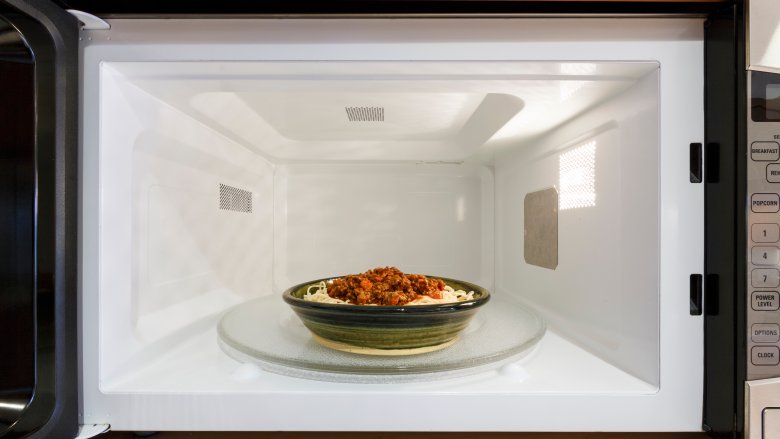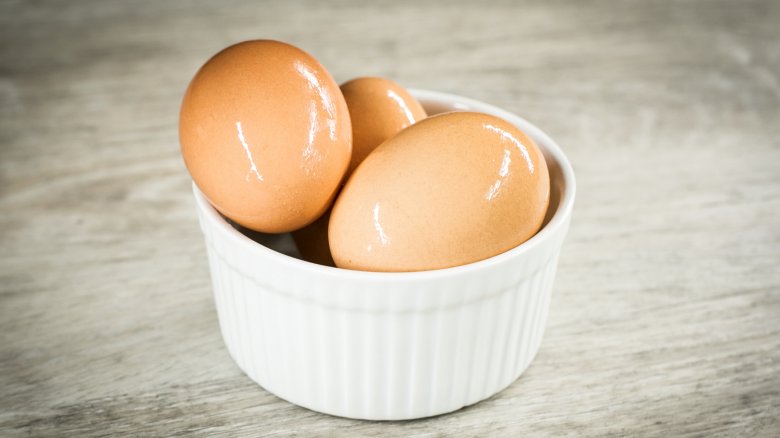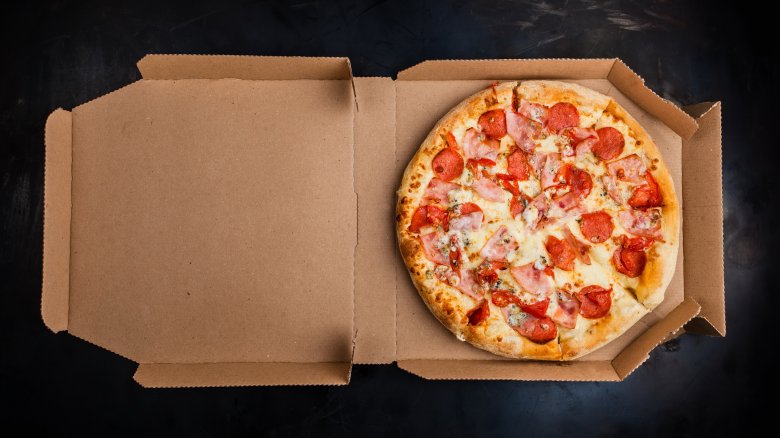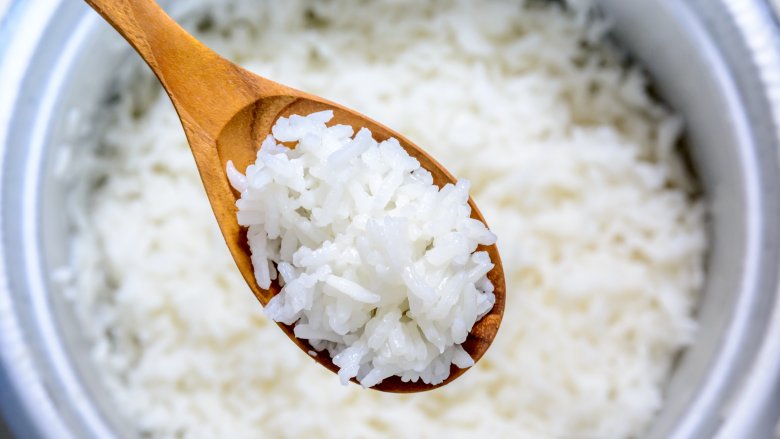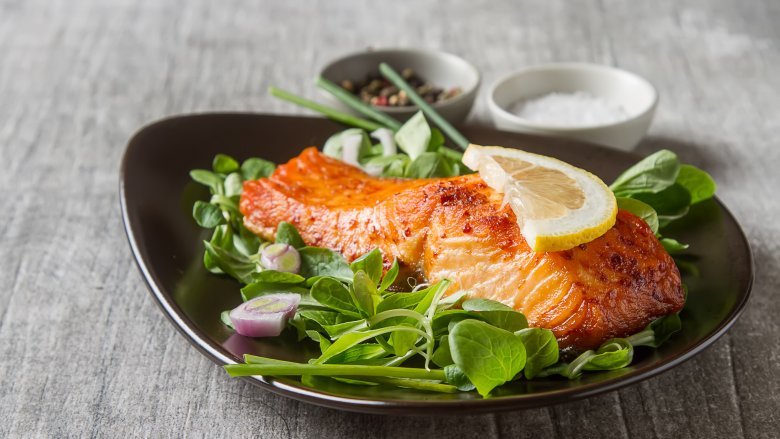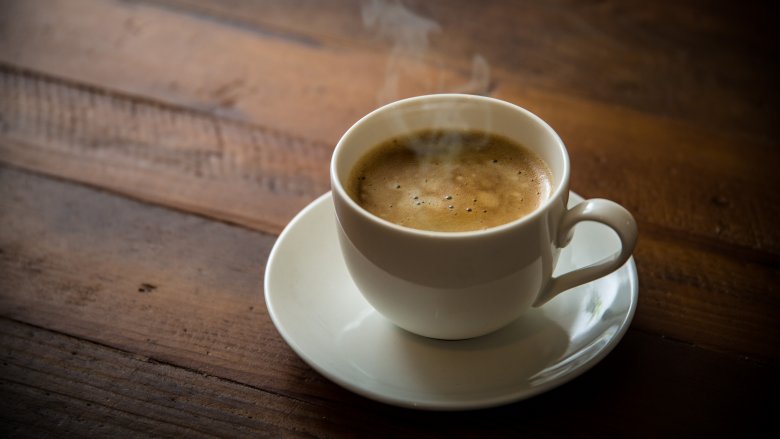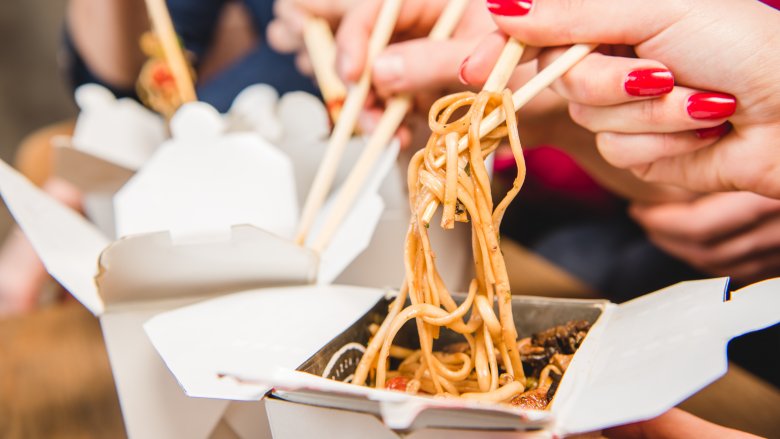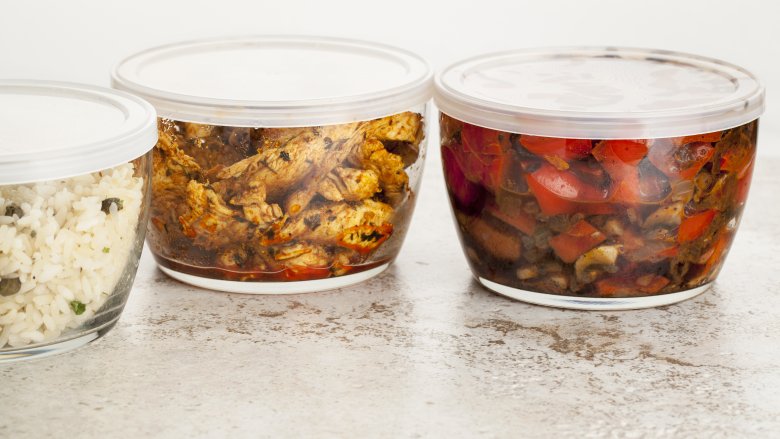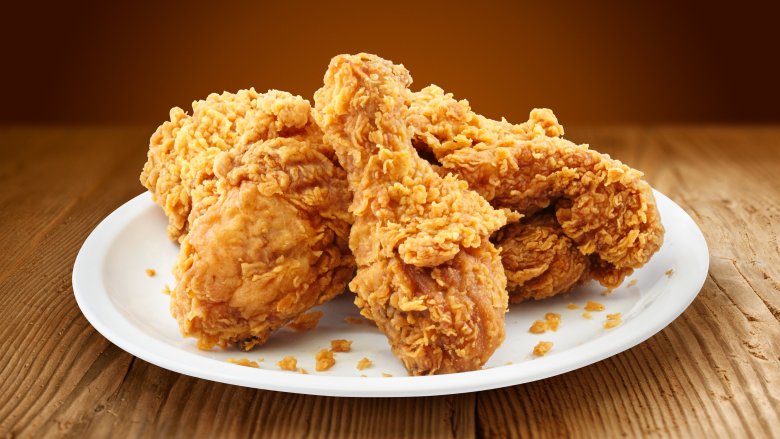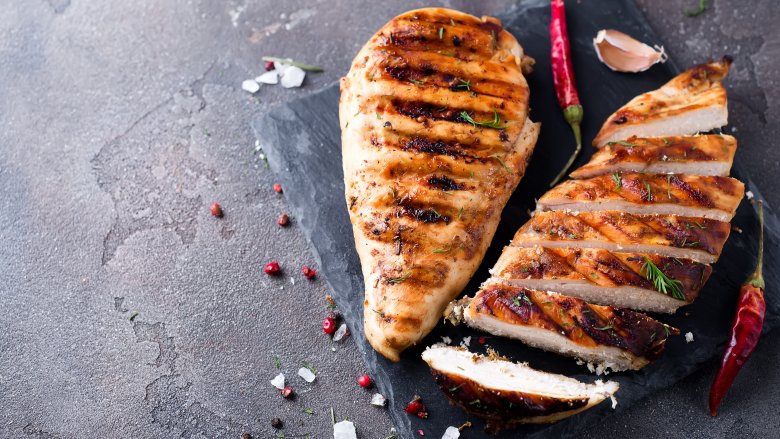The Real Reason You Shouldn't Reheat These Foods In The Microwave
Yes, the microwave is something of a wonder appliance. Yes, it can make quick work of a job that would otherwise take five times as long in the oven or on the stovetop, and yes, it regularly saves us on the days we're too lazy to cook, when we can only muster the energy for nuking a frozen dinner. But, as miraculous a machine as the microwave is, it's not always the best option when it comes to reheating foods.
In some cases, your leftover dinner could become hazardous to your health after a few minutes in the microwave. Other times, reheating your food is just plain gross — think soggy pizza and dried-out fish — and there are far better ways to treat your next-day grub. Before you zap last night's chicken dinner, find out the real reason why reheating these foods (and one drink) in the microwave might not be the best idea.
Hard-boiled eggs
Everyone knows that freshly cooked, still warm hard-boiled eggs are the best — once you stick those bad boys in the refrigerator, their tastiness factor goes down by about half. But if you're thinking about tossing them into the microwave to return them to their former glory, don't. Rather than find out the hard way, we're going to let you in on a little secret: Nuking a hard-boiled egg can cause it to explode — maybe it will explode in the microwave, or maybe it will wait until you pierce the shell and you'll get an unexpected egg shower. Either way, it will be messy.
Because water remains inside the yolk after the initial cooking, reheating a hard-boiled egg in the microwave can cause that water to superheat above boiling point. When this happens, pressure builds in the yolk but has nowhere to escape. If disturbed, that pressure can cause an explosion as the water within turns to steam, and although it doesn't happen every time, it's just not worth the risk.
To safely reheat your already-cooked eggs without the possibility of an explosion, simply cover them with boiling water and let sit for 10 minutes.
Pizza
There are few leftovers as disappointing as a slice of pizza that's been reheated in the microwave. The delicious crust that was once slightly crisp and slightly chewy morphs into a soggy mess, and the cheese takes on a congealed texture not dissimilar to rubber cement. And forget about getting the whole slice heated evenly — you know that the edges will be molten hot and the middle will be cold, every single time. But there is a better way...
It might take a little longer than a 45-second spin in the microwave, but once you reheat your pizza in the oven, you'll never again sacrifice another slice. The secret to reviving cold pizza is to preheat your oven to 400 degrees with a baking sheet inside. Once the oven comes to temperature, place the pizza on the smoking hot baking sheet, and voilà, 10 minutes later you'll be thinking you just pulled your slice out of a wood-fired oven.
Starchy foods
Does last night's dinner contain a starch? If so, the microwave might not be the best place to reheat those leftovers — but it all depends on how they were stored.
Reheating rice in the microwave is okay, provided that it was cooled within one hour of cooking, and has not been stored in the fridge for longer than one day — if not, it's a roll of the dice. This is because uncooked rice can contain spores of a bacteria called bacillus cereus, and those spores can survive the initial cooking process. If the rice is left at room temperature for too long and the toxin-producing bacteria forms, the likelihood of food poisoning increases, even after microwaving.
Food safety trainer Dorothy Richmond told SBS Food you should beware of any starchy leftovers. "It's not just rice that's the problem with bacillus cereus; it's anything starchy really," like leftover noodles, pasta, and potatoes. With potatoes it's botulism you have to worry about, and the problem arises when baked spuds are stored in their foil, creating an environment for bacteria to thrive. Like bacillus cereus, botulinum is not killed by the microwave reheating process, so proper refrigeration — sans foil jacket — is a must.
Fish
When it comes to what foods not to microwave, fish is often at the very top of the list, if for no other reason than it just plain stinks. But aside from the seriously strong smell you will subject your family or co-workers to, there's another good reason not to microwave fish: It ruins it.
Think about that perfectly cooked, tender salmon from last night's dinner. If you're following safety guidelines, you'll want to reheat it to about 125 degrees. After a couple minutes in the microwave on high, that fish will be hot enough, but it will also be totally dried out. Nobody wants a stinky house and salmon jerky.
Instead, use the oven to very gently reheat thicker cuts of fish. Warm leftover fillets at 275 degrees on a baking sheet for about 15 minutes, and don't forget cover it with foil to further ensure it says nice and moist. And if the microwave is your only option, you're better off just eating it cold.
Coffee
There are two kinds of people in this world: Those who would rather go through caffeine withdrawals than drink a cup of joe that was brewed more than 60 seconds ago, and those who would lap up a puddle of coffee from a dirty sidewalk to get their fix. The puddle drinkers also happen to be the people who microwave their day-old java without a second thought. Shudder.
There's nothing wrong with microwaved coffee, per se — it doesn't morph into a dangerous cup of toxins or anything — but nuking it definitely changes the taste. As it cools it becomes more acidic, and more acidity means bitter coffee. Unfortunately, the reheating process doesn't reverse that bitterness.
Tasting Table spoke to expert Todd Carmichael, co-founder of La Colombe Coffee Roasters, and his advice is clear: You should never reheat a cup of joe. Period. "Reheating reorganizes the chemical makeup of the coffee and totally ruins the flavor profile, Carmichael says. "Some things just don't work to reheat, and coffee is one of them. It's always best just to brew a fresh cup." If you just don't have time for that, he recommends — worst come to worst — turning a cooled cup into iced coffee instead.
Chinese food
Leftover Chinese might be the one food you can eat cold that's almost as good as freshly cooked. But almost doesn't always cut it, and for those times when you want to properly resuscitate your chow mein or fried rice, do not turn to the microwave.
Sure it will get the job done fast, but there are a two good reasons to use the stovetop instead. For starters, while it might be tempting to shove the whole take-out container into the microwave and press start, that tiny metal handle makes it a bad idea as it has the potential to overheat and burn the paper carton. Fire danger aside, nuking your leftover Chinese doesn't do it any favors in the texture department — it often turns slimy and soggy. The solution? Just heat a large pan over high heat, add a little oil, and quickly reheat your leftovers — think stir-fry. This method revives noodles, rice, and veggies equally well, and doesn't take much longer than the microwave.
Anything that's already been reheated
You're eyeing that take-out that's already been through the microwave twice this week, but is it still safe to eat?
You'll run into conflicting opinion when it comes to reheating leftovers multiple times — NHS recommends, for example, "When defrosted, food should be reheated only once, because the more times you cool and reheat food, the higher the risk of food poisoning."
However, Lydia Buchtmann, spokesperson for the Food Safety Information Council, says that there's a caveat to that: "You can reheat food as many times as you like," she explains to SBS Food. "But you need to reheat it to [about 165 degrees] and the only way you can work that out is by using a cooking thermometer," which must be measured at the center of the dish. As the microwave tends to leave cold spots, this ensures that any bacteria that has formed will be destroyed, but in the process of reheating a dish over and over to such a high temperature, safe as it may be, think about what it's doing to the quality of the dish. Each time you nuke that container of chicken noodle soup, say, the chicken is getting tougher, and the noodles and veggies are disintegrating into mush. At the end of the day, for the sake of the food, it's probably best to abide by the "one reheat" rule.
Fried chicken
Fried chicken — another food that suffers dramatically from a few minutes in the microwave. That once crunchy coating is now sad and soggy, and chances are good that the middle of your drumstick is still cold. At this point you'd be better off eating it straight out of the refrigerator, but before you resort to that, give this tried and true technique a try.
Cook's Illustrated tested several methods of reheating fried chicken, and weeded out all the fails — one of them being the microwave, of course. The best method, they say, is to let the chicken come to room temperature for at least 30 minutes, then place it in a 400 degree oven on a wire rack set in a baking sheet. Depending on the cut and size of the piece, it can take up to 18 minutes to heat through to the desired temperature of 120 degrees. But thanks to the wire rack, the entire surface of the chicken returns to its former crispy perfection, even the bottom.
Meat and poultry
When it comes to leftover beef, pork, and chicken, microwaves may not always be your best bet, and that's typically due to operator error. The problem is that if the meat is not cooled and stored properly — within two hours of cooking — bacteria can start to reproduce, and since we often don't follow the recommended guidelines when it comes using the microwave, like rotating the food or ensuring it's reheated to temperature, any bacteria that has formed won't be safely eliminated.
In a study that examined a salmonella outbreak among 30 people who ate leftover pork (which had been left out for more than 17 hours after its initial cooking), all 10 of those who microwaved the meat to reheat it became ill, while the 20 who used the oven or the stovetop did not. The study concluded that "compared with conventional methods of reheating, microwave ovens had no protective effect in preventing illness."
